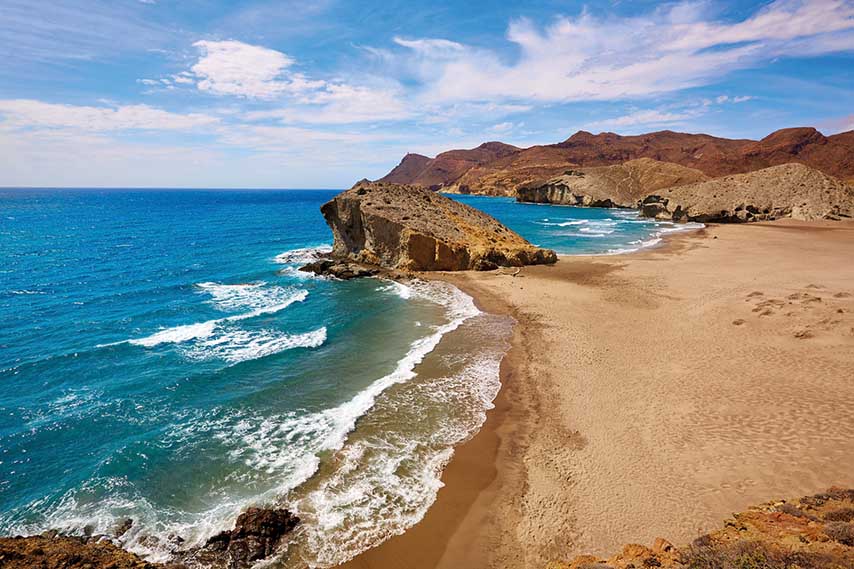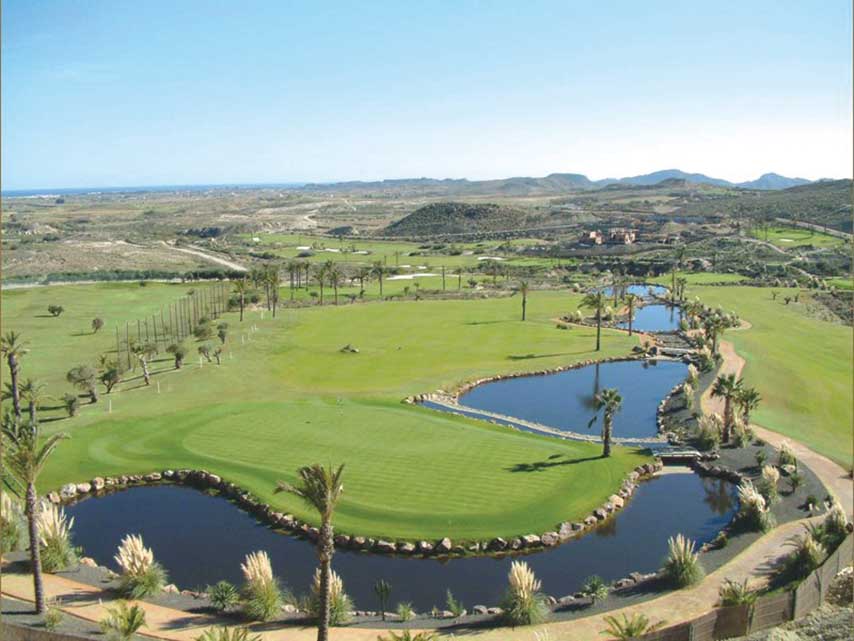Almería, the easternmost province in Andalucía, enjoys more than 200 kilometres of coastline and two well-differentiated areas, the east and west, separated by the Cabo de Gata-Níjar maritime natural park. One of the characteristics that best defines Almería is the sun. The province records an average of 3,100 hours of sun a year, an ideal climate to enjoy its golf courses.

The province of Almería is no stranger to foreign visitors, and present-day tourists are fortunate that their forerunners contributed so much of their cultures. By sea and land to Andalucía’s southeastern gateway came the Greeks, Phoenicians, Romans, Carthaginians and Moors, all of whom left behind evidence of their passing which we can see for ourselves to this day.
You need look no farther than the red stone of the Moorish Alcazaba rising above the city of Almería, an enormous structure which dominates the city skyline and whose construction took 20,000 men. Indeed, it was the Moors who founded this city and, under the Omayyad Caliphate, it became the most important seaport in Iberia. Then came the Reconquest under the Catholic monarchy, who later built Almería’s impressive cathedral and whose Castilian roots can still be seen in the province’s northern towns and villages.
The countryside of Almería is a study in contrasts. Its 232 kilometres of Mediterranean coastline are dotted with limestone cliffs and volcanic outcrops punctuated by long stretches of sandy beaches and little coves. In the Cabo de Gata-Níjar nature park, Andalucía’s largest sea-land reserve, skindiving and saltwater fishing are popular activities in its crystal-clear waters, while farther inland the landscapes are mountainous, arid and volcanic.
Tabernas desert, only 40 kilometres from the provincial capital, bears such a close resemblance to the deserts of New Mexico that it was the backdrop for scores of “spaghetti westerns”, hence the fascinating “World of Cinema” excursion so popular among tourists. To the west are mountain slopes, pine forests, trout streams and the soaring Sierra Nevada mountain range.
Tourism today is mainly centred on the city of Almería and the towns of Roquetas de Mar, Aguadulce and El Ejido. Almerimar is an outstanding resort centre with all kinds of sports facilities. The province’s golf courses, whose lush greenery provides a stark contrast with the dry Almerian countryside, especially in summer, include Almerimar, designed by Gary Player, Playa Serena in Roquetas del Mar, Cortijo Grande in Turre, La Envía near the capital, Huercal, Marina de la Torre, Desert Springs, Golf Valle del Este, Aguilón and Playa Macenas.
.
 ok WEB.jpg)
Golf Almerimar
The golf course at Almerimar, built in 1976, is part of a comprehensive resort complex including two hotels, apartments, other sports facilities and a marina. The course was designed by Rob Kirby and Gary Player and features wide fairways, though nowadays players must beware of the trees which have, with time, matured. The greens are large though well protected by bunkers, and seven holes are affected by water hazards.
Country Club La EnvÍa Golf
Located in a beautiful valley, La Envia Golf and Country Club is surrounded by mountains which protect the 18-hole golf course from easterly and westerly winds, creating superb golfing conditions. La Envia is an oasis in the middle of a spectacular desert.
Palm trees, mimosa trees, agaves and many indigenous shrubs line each of the 18 holes, which are laid out in an irregular profile.
Bunkers and lakes will also exercise your accuracy, expertise and skill as a golfer.
The course is at the heart of an ambitious project, residential and hotel, with many sport facilities. La Envia Golf Club has, among other facilities, a marvellous restaurant.
.

Alborán Golf
Located near Almería capital, in the El Toyo tourist complex close to the Cabo de Gata nature park, and designed by Ramón Espinosa, the 18-hole, par-72 Alborán championship golf course extends over 6,278 metres and includes an extensive practice area next to the clubhouse. The design has achieved a balance between the different holes – both in length and orientation – while the actual course features two lakes that come into play (and store water for irrigation) on the front nine, and 66 bunkers distributed throughout the 18 holes. Alborán Golf was the golfing venue in the 2005 Mediterranean Games.
Club de Golf Playa Serena
Playa Serena, five kilometres from Roquetas del Mar, is a mature seaside course which presents a certain degree of difficulty because of the winds, some unforgiving rough and water hazards on no fewer than 12 holes. The fairways on this course, which was designed by Angel Gallardo and Peter Alliss, are mostly flat but the small greens are sloping and many are protected by bunkers. Watch out for the seventh and the 13th, both of which require a particularly good tee shot. Acacias, pines and palms are abundant, offering welcome shade. Nevertheless, wear a hat and take water! The clubhouse has a new bar, restaurant and meeting rooms.
Aguilón Golf
This latest course opened in Almería province is a spectacular 18-hole layout, designed meticulously to adapt to the stunning landscape of the surrounding area. The result is an exemplary integration into and interaction with the natural aspects of the original plot. In addition to its absolute integration into the original topography, it is a comfortable layout for players, while being both attractive and challenging. The course features a spectacular, somewhat out of the ordinary design, with more than 100 bunkers, six large lakes and a large number of natural gullies – all of which make playing on this course an unforgettable experience.
Marina Golf Mojácar
Designed by D. Ramón Espinosa, the Marina Golf Mojácar course was inaugurated in 2000 at an extraordinary location on the Mojácar coast. The course has undergone constant improvements to its tree and plant landscape: it might not be a long layout but it is like a beautiful garden for playing golf beside the sea with spectacular views from various points, especially the fourth tee and the shot to the 13th green.
Mojácar Golf comprises an 18-hole, par-71 course, four pitch-and-putt par-three holes, and an expansive practice area with 25 tees (nine covered).
Golf Valle del Este
Vera, in Almería, had been waiting years for a golf course and finally through Golf Valle del Este the dream of so many people came true in 2002. This is Europe’s second desert course. Designed by José Canales, who closely studied techniques in Arizona before moving machinery on to this prime site, the course winds through low hills and brush where there is a stark contrast between the green of the golf and its arid surroundings. The autochthonous trees, olive, carob, fig and palms trees, and sparta grasses add to the natural environment, which the developers have been careful to respect. The sea is visible from several holes. Valle del Este is located 40 minutes east of Almería international airport, an hour from Murcia and two hours from Alicante.
.

Desert Springs Golf Club
In the last “forgotten” corner of the Mediterranean coast of south-eastern Spain on a plateau overlooking the Almanzora Valley, with easy access from the international airports of Almería (40 minutes) and Alicante (one hour, 50 minutes), Desert Springs has constructed Europe’s first ever Arizona-style desert golf course.
Here the talk is of water courses, hardpan, armadillos and cactus and there is, of course, about one-half the green planted area you’d find on a regular course. But this is the desert where Clint Eastwood and Sergio Leone made “A Fistful of Dollars” and a host of other westerns, so a tough golf course fits in perfectly. Not that Desert Springs is especially tough. It just looks, well, rugged with towering outcrops of sandstone rock. Eventually there will be two courses on the site. For the time being, be among the first to enjoy the original. Desert Springs is certainly that and it offers a challenging round of golf.
Cortijo Grande Golf Resort
This is a great little course. Located in a fertile valley near Mojácar, four kilometres from the beach, Cortijo Grande is a predominantly flat layout. Lemon and orange trees add colour to its fairways. The course doesn’t have a clubhouse but there’s a bar-restaurant nearby. The course is ideal for year-round play thanks to the benign climate.




